|
All
glories to Sri Guru and Sri Gauranga
Seva of many types: renewing the verandah flooring
|
 |
|
|||||
|
|
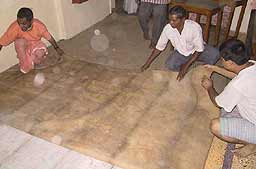 Prabhus
Bipal Krishna (L) and Gaura Chandra assist the professional installer, Dev
Das, in rolling up the old carpet. [The glowing circles of light are reflections
of the camera flash on dust particles.] Prabhus
Bipal Krishna (L) and Gaura Chandra assist the professional installer, Dev
Das, in rolling up the old carpet. [The glowing circles of light are reflections
of the camera flash on dust particles.] |
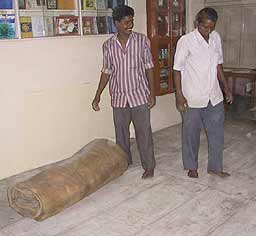 The
old carpet, full of dust and dirt, is rolled up to be taken for a thorough
washing and application of a new backing so that it can be used elsewhere
in the Math. The
old carpet, full of dust and dirt, is rolled up to be taken for a thorough
washing and application of a new backing so that it can be used elsewhere
in the Math. |
 The
new flooring is a PVC material (locally called vinyl) much like rolled linoleum
in appearance. Above (in order of preference from L to R) are the most favored
color choices of Srimati Malati Priya our color coordinator for the project.
The middle sample turned out to be the only one of the three that was actually
available and is the one that was installed. The
new flooring is a PVC material (locally called vinyl) much like rolled linoleum
in appearance. Above (in order of preference from L to R) are the most favored
color choices of Srimati Malati Priya our color coordinator for the project.
The middle sample turned out to be the only one of the three that was actually
available and is the one that was installed. |
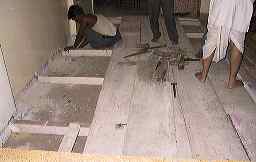 Removal
of the old wood slats revealed why they had the flexibility of a diving
board. They were 3/4" slats placed on beams spaced 32" to 40"
apart. While sufficient to support the weight of the devotees, properly
placed footsteps could cause the doors of the bookshelf to swing open. Removal
of the old wood slats revealed why they had the flexibility of a diving
board. They were 3/4" slats placed on beams spaced 32" to 40"
apart. While sufficient to support the weight of the devotees, properly
placed footsteps could cause the doors of the bookshelf to swing open. |
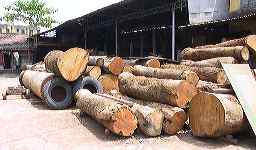 Purchasing
lumber in Kolkata means a trip to the mill. Whole logs are brought in and
cut to size on the spot. Purchasing
lumber in Kolkata means a trip to the mill. Whole logs are brought in and
cut to size on the spot. |
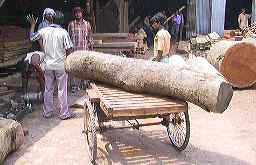 Here's
one now, just cut from a tree and brought to the mill by rickshaw. Here's
one now, just cut from a tree and brought to the mill by rickshaw. |
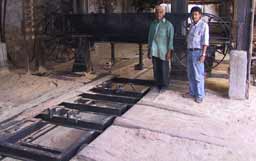 You'll
need a large saw to cut such logs. Here our contractor, Suresh (on the right),
stands with the sawyer in front of the saw. The logs are rolled onto a moveable
bed which carries them through the band saw blade which cuts them into thick
rough sawn slats... You'll
need a large saw to cut such logs. Here our contractor, Suresh (on the right),
stands with the sawyer in front of the saw. The logs are rolled onto a moveable
bed which carries them through the band saw blade which cuts them into thick
rough sawn slats... |
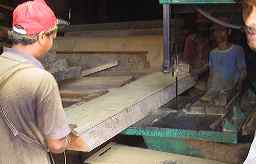 ...like
this one, being readied for the next cut. Our beams will be cut to 3"x4"
here. ...like
this one, being readied for the next cut. Our beams will be cut to 3"x4"
here. |
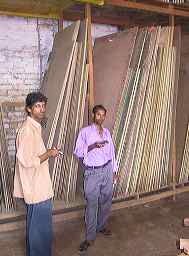 Plywood
will go on top of the old floor to provide a firm smooth surface for the
new "Vinyl" flooring. As you go through this process you'll see
a theme developing, it's called doubling. The vinyl sellers recommended
a plywood underlayment of 4 mm to 8 mm thickness. We decided on 19 mm (3/4").
[Doubling is the conversion rate used for changing traditional Indian building
materials dimensions to Western standards.] Plywood
will go on top of the old floor to provide a firm smooth surface for the
new "Vinyl" flooring. As you go through this process you'll see
a theme developing, it's called doubling. The vinyl sellers recommended
a plywood underlayment of 4 mm to 8 mm thickness. We decided on 19 mm (3/4").
[Doubling is the conversion rate used for changing traditional Indian building
materials dimensions to Western standards.] |
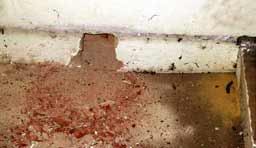 Using
a masonry drill and chisle, holes are cut into the concrete walls to accept
the new beams. Using
a masonry drill and chisle, holes are cut into the concrete walls to accept
the new beams. |
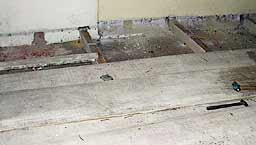 After
all the holes have been cut... After
all the holes have been cut... |
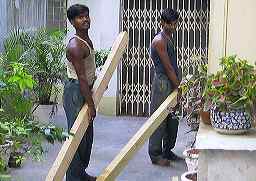 ...the
new beams arrive freshly sawn from a log at the mill... ...the
new beams arrive freshly sawn from a log at the mill... |
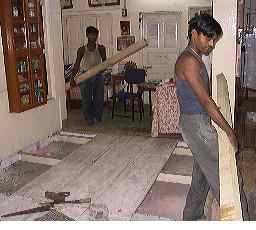 ...and
are brought to Srila Govinda Maharaj's room. ...and
are brought to Srila Govinda Maharaj's room. |
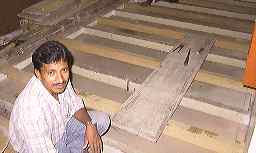 The
new floor joists are set in place, doubling the previous number from 5 to
10. The
new floor joists are set in place, doubling the previous number from 5 to
10. |
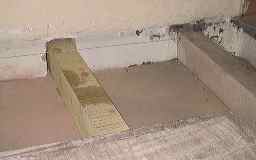 The
floor joists are adjusted to a common height using a line level. The
floor joists are adjusted to a common height using a line level. |
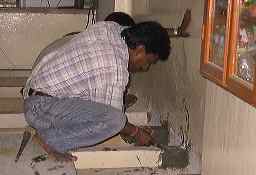 Mortar
is then applied to set the joists in their permanent position. Afterwards
wood blocking was secured between each joist to prevent lateral movement
and twisting. This also provided a new solid flat surface to secure the
ceiling below around its full perimeter. Mortar
is then applied to set the joists in their permanent position. Afterwards
wood blocking was secured between each joist to prevent lateral movement
and twisting. This also provided a new solid flat surface to secure the
ceiling below around its full perimeter. |
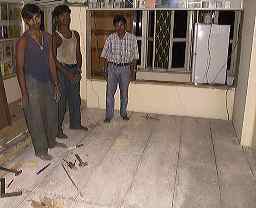 The
old flooring is now set in place and secured with screws instead of nails. The
old flooring is now set in place and secured with screws instead of nails. |
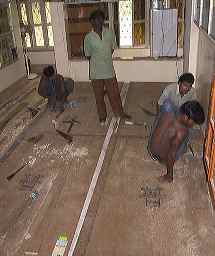 The
new 3/4" plywood floor is carefully fitted and secured on top of the
old 3/4" wood slats thus doubling the thickness of the floor to add
further stiffness. The
new 3/4" plywood floor is carefully fitted and secured on top of the
old 3/4" wood slats thus doubling the thickness of the floor to add
further stiffness. |
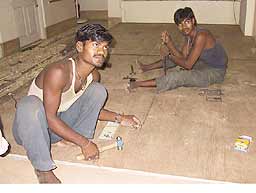 Careful
monitoring prevented the carpenters (Sanjay & Sanjay) from hammering
the screws into the wood, as they are accustomed to do, instead of screwing
them in. Careful
monitoring prevented the carpenters (Sanjay & Sanjay) from hammering
the screws into the wood, as they are accustomed to do, instead of screwing
them in. |
|
|
|
|
|
|
|
|
|
|
|
|
|
Epilogue- Devotees and friends of the New York/New Jersey Math such as Lila Sundari Devi, Gokulananda Prabhu and Srimati Rita Stokes contributed the funds necessary for the work and materials. Suresh, the contractor who bid on the job expecting it to be finished in 2 days, would not ask for any additional money even after working two, twelve hour days and an additional two days after that. In the end we offered to pay something extra for the additional time and everyone was satisfied. Finally, Srila Govinda Maharaj himself was extraordinarily gracious in allowing us enough latitude to change the entire look and feel of his floor without so much as questioning what we were doing. In the end, fearing he may come to Kolkata from Navadwipa before the work was finished, we had to suggest that he continue to enjoy the beautiful and nourishing environment there for a few more days. He happily agreed and we were able to finish a job that may have been greatly disturbing for him had he been in Kolkata at the time. Jaya Om Vishnu Pada Srila Bhakti Sundar Govinda Dev Goswami Maharaj, Ki Jaya! —Swami B.K. Giri |